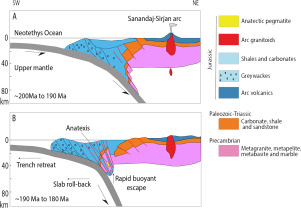当前位置:
X-MOL 学术
›
Gondwana Res.
›
论文详情
Our official English website, www.x-mol.net, welcomes your feedback! (Note: you will need to create a separate account there.)
Geochronology and geochemistry of subducted Cadomian continental basement in central Iran: Decompressional anatexis along the Jurassic Neotethys margin
Gondwana Research ( IF 6.1 ) Pub Date : 2020-06-01 , DOI: 10.1016/j.gr.2020.01.005 Rezvaneh Jamali Ashtiani , Jamshid Hassanzadeh , Axel K. Schmitt , Masafumi Sudo , Martin Timmerman , Christina Günter , Edward Sobel
Gondwana Research ( IF 6.1 ) Pub Date : 2020-06-01 , DOI: 10.1016/j.gr.2020.01.005 Rezvaneh Jamali Ashtiani , Jamshid Hassanzadeh , Axel K. Schmitt , Masafumi Sudo , Martin Timmerman , Christina Günter , Edward Sobel

|
Abstract Late Neoproterozoic-Early Cambrian calc-alkaline granitoids are ubiquitous in the continental basement of Iran and indicate formation within a Cadomian arc system at the northern margin of Gondwana. A basement complex comprising mainly mica schist, paragneisses, and metagranite along with metabasite and rare pegmatite is exposed in the Zayanderud region north of Shahrekord located in the hinterland of the Zagros mountain range. This complex is unique in the Neotethyan realm because it includes eclogites with Jurassic metamorphic ages implying involvement of continental crust at the onset of subduction. Ion microprobe U Pb zircon dating along with trace element and oxygen isotope analyses for metagranites define two zircon age clusters of ca. 552 and 565 Ma confirming connection with the other Ediacaran age basement arc plutons in the belt. Zircon geochronology for pegmatite, by contrast, yielded a concordant age population averaging 176.5 ± 3.3 (2σ) Ma. Zircon crystals from the pegmatite also have unusually low rare earth element (REE) abundances with sharp increases towards the heavy REE. Along with an absence of a negative Eu anomaly, this indicates a high-grade metamorphic origin of zircon crystallizing from a pegmatite which was formed by melting of mica schist and possibly amphibole eclogite during decompression where incipient garnet breakdown released Zr and HREE to form zircon, and LREE were retained in stable apatite and titanite. Corresponding 40Ar/39Ar phengite dates from the pegmatite and the mica schist country-rock are overlapping with or only slightly postdate the U Pb zircon ages, indicating rapid cooling after reaching maximum metamorphic pressure in the Early Jurassic. The Zayanderud basement complex is thus potentially a rare example of deep burial of continental crust and rapid exhumation due to buoyant escape during the incipient stages of subduction, well before the ultimate closing of the Neotethys ocean basin between Arabia and Eurasia in the mid-Tertiary.
中文翻译:

伊朗中部俯冲Cadomian大陆基底的年代学和地球化学:侏罗纪新特提斯边缘的减压深熔区
摘要 晚新元古代-早寒武世钙碱性花岗岩普遍存在于伊朗大陆基底,表明在冈瓦纳大陆北缘的卡多米弧系统内形成。在位于 Zagros 山脉腹地的 Shahrekord 以北的 Zayanderud 地区出露了一个主要由云母片岩、副片麻岩和变花岗岩以及变玄武岩和稀有伟晶岩组成的基底复合体。这个复合体在新特提斯界是独一无二的,因为它包括具有侏罗纪变质时代的榴辉岩,这意味着在俯冲开始时大陆地壳的参与。离子微探针 U Pb 锆石测年以及变花岗岩的微量元素和氧同位素分析确定了两个约 552 和 565 Ma 证实了与带中其他埃迪卡拉纪基底弧岩体的联系。相比之下,伟晶岩的锆石年代学产生了一致的年龄群体,平均为 176.5 ± 3.3 (2σ) Ma。伟晶岩中的锆石晶体也具有异常低的稀土元素 (REE) 丰度,并且随着重稀土元素的急剧增加。除了没有负 Eu 异常外,这表明从伟晶岩结晶的锆石是高品位变质成因,伟晶岩是由云母片岩和可能的角闪石榴辉岩在减压过程中熔化形成的,其中初期石榴石分解释放 Zr 和 HREE 形成锆石,和 LREE 保留在稳定的磷灰石和钛石中。来自伟晶岩和云母片岩乡村岩的相应 40Ar/39Ar phengite 年代与 U Pb 锆石年龄重叠或仅稍晚于 U Pb 锆石年龄,表明早侏罗世达到最大变质压力后迅速冷却。因此,扎扬德鲁德基底复合体可能是大陆地壳深埋和由于俯冲初期阶段的浮力逃逸而迅速剥脱的一个罕见例子,早在第三纪中期阿拉伯和欧亚大陆之间的新特提斯洋盆最终关闭之前。
更新日期:2020-06-01
中文翻译:

伊朗中部俯冲Cadomian大陆基底的年代学和地球化学:侏罗纪新特提斯边缘的减压深熔区
摘要 晚新元古代-早寒武世钙碱性花岗岩普遍存在于伊朗大陆基底,表明在冈瓦纳大陆北缘的卡多米弧系统内形成。在位于 Zagros 山脉腹地的 Shahrekord 以北的 Zayanderud 地区出露了一个主要由云母片岩、副片麻岩和变花岗岩以及变玄武岩和稀有伟晶岩组成的基底复合体。这个复合体在新特提斯界是独一无二的,因为它包括具有侏罗纪变质时代的榴辉岩,这意味着在俯冲开始时大陆地壳的参与。离子微探针 U Pb 锆石测年以及变花岗岩的微量元素和氧同位素分析确定了两个约 552 和 565 Ma 证实了与带中其他埃迪卡拉纪基底弧岩体的联系。相比之下,伟晶岩的锆石年代学产生了一致的年龄群体,平均为 176.5 ± 3.3 (2σ) Ma。伟晶岩中的锆石晶体也具有异常低的稀土元素 (REE) 丰度,并且随着重稀土元素的急剧增加。除了没有负 Eu 异常外,这表明从伟晶岩结晶的锆石是高品位变质成因,伟晶岩是由云母片岩和可能的角闪石榴辉岩在减压过程中熔化形成的,其中初期石榴石分解释放 Zr 和 HREE 形成锆石,和 LREE 保留在稳定的磷灰石和钛石中。来自伟晶岩和云母片岩乡村岩的相应 40Ar/39Ar phengite 年代与 U Pb 锆石年龄重叠或仅稍晚于 U Pb 锆石年龄,表明早侏罗世达到最大变质压力后迅速冷却。因此,扎扬德鲁德基底复合体可能是大陆地壳深埋和由于俯冲初期阶段的浮力逃逸而迅速剥脱的一个罕见例子,早在第三纪中期阿拉伯和欧亚大陆之间的新特提斯洋盆最终关闭之前。


























 京公网安备 11010802027423号
京公网安备 11010802027423号